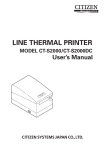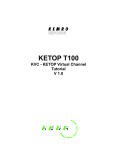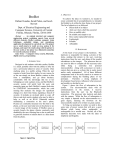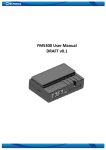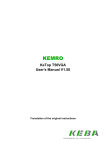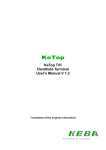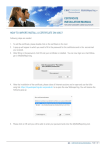Download 5 KEBA Standard Protocol
Transcript
KeTop T40 Handheld Terminal KEBA Standard Protocol User’s Manual V 1.1 Notes on This Manual At various points in this manual you will see notes and precautionary warnings regarding possible hazards. The meaning of the symbols used is explained below. ! DANGER z DANGER indicates an imminently hazardous situation which, if not avoided, will result in death or serious injury. ! WARNING z WARNING indicates a potentially hazardous situation which, if not avoided, could result in death or serious injury. ! CAUTION z CAUTION indicates a potentially hazardous situation which, if not avoided, may result in minor or moderate injury. CAUTION z CAUTION used without the safety alert symbol indicates a potentially hazardous situation which, if not avoided, may result in property injury. This symbol reminds you of the possible consequences of touching electrostatically sensitive components. Note Notes on use of equipment and useful practical tips are identified by the “Notice” symbol. Notices do not contain any information that draws attention to potentially dangerous or harmful functions. © KEBA 2005 Specifications are subject to change due to further technical developments. Details presented may be subject to correction. All rights reserved. Document: version 1.1 / material no.: 61869 Filename: t40_stdprot_en.doc, last saving on: 10. 12. 2004 KEBA AG, Postfach 111, Gewerbepark Urfahr, A-4041 Linz Tel.: ++43 / 732 / 70 90-0, Fax: ++43 / 732 / 73 09 10, E-Mail: [email protected], www.keba.com KEBA GmbH, Ulmer Straße 123, D-73037 Göppingen Tel.: ++49 / 7161 / 97 41-0*, Fax: ++49 / 7161 / 97 41-40 KEBA Corp., 100 West Big Beaver Road, Troy, MI 48084 Tel. ++1 / 248 / 526 - 0561, Fax: ++1 / 248 / 526 - 0562, E-Mail: [email protected] KEBA Standard Protocol Contents History Modification from / to V1.0 V1.0/V1.1 Date July 02 12-2004 Modified pages all User's Manual, version: 1.1 / material no.: 61869 © KEBA 2005 Description Author First edition New Layout sam sam 3 Contents 4 KeTop T40 User's Manual, version: 1.1 / material no.: 61869 © KEBA 2005 KEBA Standard Protocol Contents Contents 1 Introduction.....................................................................................................................................7 2 Connection ......................................................................................................................................8 3 Configuration of KeTop T40 ..........................................................................................................9 Configuration Software .............................................................................................................9 Configuration.............................................................................................................................9 4 Power-Up Phase ...........................................................................................................................10 5 KEBA Standard Protocol .............................................................................................................11 Features ..................................................................................................................................11 Structure of Messages ............................................................................................................11 Control Characters..................................................................................................................12 Checksum Calculation (BCC) .................................................................................................12 Protocol Sequence..................................................................................................................13 Overview of Messages............................................................................................................14 6 KeTop System Variables..............................................................................................................16 7 KeTop Functions ..........................................................................................................................18 Keypad ....................................................................................................................................18 LEDs .......................................................................................................................................22 Texts .......................................................................................................................................25 Text Monitor ............................................................................................................................27 Variables .................................................................................................................................30 Buzzer Activation ....................................................................................................................35 System Reset..........................................................................................................................35 Communication Timeout .........................................................................................................36 Menu Access/Exit ...................................................................................................................36 Special Functions....................................................................................................................37 Graphic Functions...................................................................................................................41 8 Error Messages.............................................................................................................................49 User's Manual, version: 1.1 / material no.: 61869 © KEBA 2005 5 KEBA Standard Protocol Introduction 1 Introduction This document is a supplement to the user's manual "KeTop T40 Handheld Terminal – General Information" and exclusively refers to the KEBA standard protocol. The following chapters describe the communication between the KeTop T40 handheld terminal and a PLC using the KEBA standard protocol. The data exchange between the HT and the PLC takes place via commands that are explained in this manual on the basis of examples. This manual does not describe in detail the configuration, the basic functions and the key labelling of the KeTop. For this information, please refer to the manual "KeTop T40 Handheld Terminal – General Information". User's Manual, version: 1.1 / material no.: 61869 © KEBA 2005 7 Connection KeTop T40 2 Connection The KEBA standard protocol must be operated via a serial interface of the handheld terminal. For details about the connection of the interfaces, refer to the corresponding chapter in the manual "KeTop T40 Handheld Terminal – General Information". 8 User's Manual, version: 1.1 / material no.: 61869 © KEBA 2005 KEBA Standard Protocol Configuration of KeTop T40 3 Configuration of KeTop T40 Configuration Software For setting the device configuration and creating the texts, KEBA supplies a configuration software that is executable under Windows. The configuration is described in detail in the manual "KeTop T40 Handheld Terminal – General Information" (e.g. functions for editing the keypad layout and for loading the program) and in general also applies to the KEBA standard protocol coupling. Therefore this chapter only describes the specific details of the KEBA standard protocol. Configuration Selection of protocol After selecting the "serial KEBA standard protocol" the following protocol parameters must be set: Baudrate Selection of requested transmission rate: 9600, 19200, 38400, 57600, 115200 Baud. Parity The setting of parity is EVEN and cannot be changed. Data bit The number of data bits is 8 and cannot be changed. Stop bit The number of stop bits is 1 and cannot be changed. Numbering of variables For the serial data transmission of the KeTop, the following restriction must be taken into account in the text editing mode: User variables may be defined only from variable number 100 on. The range from 1 to 99 is reserved for the system variables (see also chapter "KeTop System Variables"). EXCEPTION: string variables (numbering from 0 to 255) User's Manual, version: 1.1 / material no.: 61869 © KEBA 2005 9 Power-Up Phase KeTop T40 4 Power-Up Phase The handheld terminal carries out a self-test after turning on. For details about the test steps, refer to the manual "KeTop T40 Handheld Terminal – General Information". ► The first part of the test is identical for each KeTop T40 coupling and thus described in the User's Manual "KeTop T40 Handheld Terminal – General Information". ► Then the configuration data are loaded. The following message is displayed: Serial Standard Vx.y Initializing... In case of an error, the handheld terminal remains in this condition. ► After the configuration data have been loaded successfully, the following mask appears on the display: Serial Standard Vx.y Channel: COMn, mmmmm ooooo,EVEN,8,1 x n m o program version number of interface port type of interface ( RS232 or RSxx2 for RS232/RS422) baud rate (9600, 19200, 38400, 57600, 115200 Baud) This mask remains on the display until the PLC activates a text display on the handheld terminal. 10 User's Manual, version: 1.1 / material no.: 61869 © KEBA 2005 KEBA Standard Protocol KEBA Standard Protocol 5 KEBA Standard Protocol The HT is used in industrial applications, especially for operating machines. Errors in the HT or during data transmission may endanger men and machine. Therefore higher demands are made on the data transmission compared to a standard ASCII terminal, for example. Features z Transmission errors can be recognized reliably through a horizontal and vertical parity check. z The HT acknowledges whether a message has been received correctly or not. In case of negative acknowledgement, the PLC must repeat the message. z The acknowledgement enables the PLC to control the time. If the response expected from the HT does not occur, the HT, the connection cable or the interface of the PLC are probably defective. Structure of Messages Each message is started with the control character STX. Then the command and the data are transmitted. The control character ETX terminates the data part. By means of the BCC checksum sent with the message, the receiver checks if the transmission has been completed successfully. Depending on the command, we distinguish between messages with fixed length and messages with variable length: Messages with fixed length z The data part may also contain the characters STX (02H) and ETX (03H). Messages with variable length z The data part only contains printable characters (ASCII code ≥ 20H), i.e. the beginning and the end of a message are clearly defined by the control characters STX, ETX and BCC. User's Manual, version: 1.1 / material no.: 61869 © KEBA 2005 11 KEBA Standard Protocol KeTop T40 Control Characters Control character EOT HEX 04 Description The HT sends this control character after the power-on self-test or after a reset command. STX 02 Start of data transmission ETX 03 End of data transmission ACK 06 The HT has correctly understood the message it received (correct checksum). NAK 15 HT has not correctly understood the message it received (wrong checksum). The send station must repeat the message. Checksum Calculation (BCC) The checksum is calculated in accordance with DIN 66219. It always consists of one byte. The following example describes the checksum calculation of the message for activating the buzzer: E.g.: PLC (control) sends to HT (handheld terminal): Buzzer activation STX 02 <command> 07 <duration> 35 Character No. Character HEX BINARY 1 2 3 4 5 STX Command Duration ETX BCC 02 07 35 03 31 00000010 00000111 00110101 00000011 00110001 ETX 03 BCC 31 Keys on VT100 terminal CNTL B CNTL G 5 CNTL C 1 The BCC checksum is calculated by the XOR logic of all characters beginning after STX and ending before the BCC. In this example the character 5 is calculated by the XOR logic of the characters 2, 3 and 4. 12 User's Manual, version: 1.1 / material no.: 61869 © KEBA 2005 KEBA Standard Protocol KEBA Standard Protocol Protocol Sequence PLC KETOP T40 CU 201 TT S AS U KETOP Serial connection HT is turned on EOT eg display text STX Cmd data ETX BCC NAK negative acknowledgement display text (repetition) STX Cmd data ETX BCC ACK positive acknowledgement eg key press STX Cmd data ETX BCC no acknowledgement Cmd ... Command Example of communication between PLC and HT User's Manual, version: 1.1 / material no.: 61869 © KEBA 2005 13 KEBA Standard Protocol KeTop T40 Overview of Messages Function Keyclick on Keyclick off Config.: signalize pressing of key Config.: signalize releasing of key Event “key pressed" Event “key released" PLC ---> HT Cmd Data ‘e’ ‘f’ ‘a’ ‘b’ - HT ---> PLC Cmd Data 1-line text call 4-line text call 8-line text call 16-line text call Clear display Position cursor Cursor attribute Text attribute (8-/16-line LCD) Text from cursor position Text line 0 Text line 1 Text line 2 Text line 3 Text line 4 Text line 5 Text line 6 Text line 7 Text xy (ASCII) Text xy (binary) ‘p‘ ‘q’ ‘Q’ ‘P’ ‘g’ ‘C’ ‘E’ ‘H’ ‘B’ ‘0’ ‘1’ ‘2’ ‘3’ ‘4’ ‘5’ ‘6’ ‘7’ ‘A’ ‘T’ [line] (text number) (text No. 0) ... (text No. 3) (text No. 0) ... (text No. 7) (text No. 0) ... (text No. 15) [line] [column] [attribute] [attribute] "text..." "text..." "text..." "text..." "text..." "text..." "text..." "text..." "text..." "line" "column" "text..." [line] [column] "text..." Set timeout ‘t’ [duration] Buzzer activation BEL "duration" Reset (warm start) ‘d’ - Status configuration ‘S’ [status sending time] [reserve (5)] [status content] Status Request key status Request code of all keys pressed Red LED map Green LED map Red flashing LED map Green flashing LED map LED on red LED on green LED flashing red LED flashing green LED off ‘h’ ‘c’ ‘L’ ‘M’ ‘F’ ‘G’ ‘+’ ‘*’ ‘%’ ‘&’ ‘-’ [G1][G2][G3][G4][G5] [G1][G2][G3][G4][G5] [G1][G2][G3][G4][G5] [G1][G2][G3][G4][G5] [LED code] [LED code] [LED code] [LED code] [LED code] Graphic functions: Pixel Line Rectangle Circle Ellipse Text ‘Z’‘P‘ ‘Z’‘L‘ ‘Z’‘R‘ ‘Z’‘C‘ ‘Z’‘E‘ ‘Z’‘T‘ (x) (y) (x0) (y0) (x1) (y1) (x0) (y0) (x1) (y1) [fill] (x) (y) (r) [fill] (x) (y) (rx) (ry) [fill] Line type Clear window Set colors Display of bitmaps ‘Z’‘l‘ ‘Z’‘c‘ ‘Z’‘o‘ ‘Z’‘B‘ (type) (x0) (y0) (x1) (y1) [fg] [bg] 14 ‘(‘ ‘)’ [key code] [key code] ‘J’ <..configured contents...> - [G1][G2][G3][G4] n * [key code] (0≤n≤5) (x) (y) [fontsize] [font_attr] „text....“ (bitmap No) (x) (y) User's Manual, version: 1.1 / material no.: 61869 © KEBA 2005 KEBA Standard Protocol KEBA Standard Protocol Function Request 1-byte variable Request 2-byte variable Request 4-byte variable Request floating point variables Request string variables PLC <---> HT Cmd Data ‘u’ (varNo) ‘v’ (varNo) ‘w’ (varNo) ‘x’ (varNo) ‘y’ [varNo] Send 1-byte variable Send 2-byte variable Send 4-byte variable Send floating point variable Send string variable ‘U’ ‘V’ ‘W’ ‘X’ ‘Y’ Cmd " " [ ] ( ) { } [length] HT <---> PLC Cmd Data ‘U’ (varNo) [Wert] ‘V’ (varNo) (Wert) ‘W’ (varNo) {Wert} ‘X’ (varNo) {Wert} ‘Y’ [varNo] [length] "value" (varNo) [value] (varNo) (value) (varNo) {value} (varNo) {value} [varNo] [length] "value" Command value in ASCII coding 8-bit value in binary coding 16-bit value in binary coding 32-bit value in binary coding All values are transmitted in the Motorola format (high byte before low byte). User's Manual, version: 1.1 / material no.: 61869 © KEBA 2005 15 KeTop System Variables KeTop T40 6 KeTop System Variables System variables offer additional functions to the user. If the system variables are sent with the corresponding index they can activate/deactivate certain functions in the handheld terminal (e.g. automatic sending of key code). The system variables range from 1 to 99 and must not be programmed by the user. At the system variables, we distinguish between 1-byte, 2-byte and 4-byte variables. Var No. Designation Data type Access HT PLC Default value Description 1-byte variables 1 (01H) 2 (02H) 3 (03H) 4 (04H) 5 (05H) 6 (06H) 7 (07H) 8 (08H) 9 (09H) 10 (0AH) 11 (0BH) 12 (0CH) 13 (0DH) 14 (0EH) 15 (0FH) 16 (10H) 17 (11H) 18 (12H) Reserved - - - - - Reserved - - - - - Reserved - - - - - Reserved - - - - - Reserved - - - - - BEEP BOOL R/W FALSE Buzzer activation (permanent tone) KEY_CLICK_PRESSED BOOL R/W FALSE Beep when pressing a key SEND_PRESSED_KEY_NR BOOL R/W FALSE SEND_RELEASED_KEY_NR BOOL R/W FALSE Reserved - - - - The HT sends the key number when a key is pressed. The HT sends the key number when a key is released. - Reserved - - - - - Reserved - - - - - SEND_KBD_MAP BOOL R/W FALSE Will not be evaluated. Reserved - - - - - Reserved - - - - - Reserved - - - - - SYSTEM_RESET UINT8 W - System reset at bitmap 55H FETCH_TEXT_VAR BOOL W FALSE 19 (13H) 20 (14H) 21 (15H) SEND_PRESSED_KEY_CODE BOOL R/W FALSE Upon text calls, the HT requests once all output variables contained in the text. Will not be evaluated. ORDER_BOX UINT8 W - Will not be evaluated. KEY_CLICK_RELEASED BOOL R/W FALSE Beep when releasing a key 16 User's Manual, version: 1.1 / material no.: 61869 © KEBA 2005 KEBA Standard Protocol KeTop System Variables Var No. Designation Data type Access HT PLC Default value Description 22 (16H) EVENT_VAR_NOT_ON_SCREEN BOOL R/W FALSE 23 (17H) 24 (18H) 25 (19H) 26 (1AH) 27 (1BH) 28 (1CH) 29 (1DH) 30 (1EH) 31 (1FH) 32 (20H) DISABLE_MENU BOOL R/W FALSE DISABLE_EDITOR BOOL R/W FALSE Reserved - - - - Event message when a variable is written, for which no output field is provided on the display => EVENT_CODE Enabling(0) or disabling(1) the main menu call (pressing the 1st and 4th key) Enabling(0) or disabling(1) the input of variables on the HT - Reserved - - - - - Reserved - - - - - EVENT_MENU BOOL R/W FALSE KBD_LOCKED BOOL R/W FALSE NEXT_FIELD_AFTER_ENTER BOOL R/W TRUE SEND_RELEASED_KEY_CODE BOOL R/W FALSE Event message upon menu access and exit => EVENT_CODE Enabling (0) or disabling (1) of the keypad on the HT After Enter is pressed, the cursor changes to the next input field. Will not be evaluated. AUTO_KEY_REPEAT BOOL R/W FALSE Automatic key repetition when key is pressed. - - - 2-byte variables 1 (01H) 2 (02H) 3 (03H) 4 (04H) 5 (05H) 6 (06H) 7 (07H) 8 (08H) Reserved - - FETCH_TEXT_VAR_CYCLE_TIME UINT16 R/W 0 BEEP_TIME UINT16 R/W 0 APPLICATION_SW_VERSION UINT16 R - DEVICE_TYPE UINT16 R - Cycle time in ms at which the HT requests all output variables displayed. Buzzer activation (duration of beep in ms) Version of HT application software Vx.y: High Byte -> x, Low Byte -> y 40 ... KeTop T40 Reserved - - - - - Reserved - - - - - AUTO_KEY_DELAY_TIME UINT16 R/W 250 Repetition rate in ms. 4-byte variables 1 (01H) 2 (02H) ERROR_CODE UINT32 W R EVENT_CODE UNIT32 W R Error message HT -> PLC (not used at present) Event message HT -> PLC: Bits 24 - 31: event number Bits 0 - 23: event-dependent information Access R W Read Write Values ranges of data types used BOOL UINT8 UINT16 UINT32 Boolean number (0 = FALSE, 1 = TRUE) integral number without sign (0...255) integral number without sign (0...65535) integral number without sign (0...4294967295) User's Manual, version: 1.1 / material no.: 61869 © KEBA 2005 17 KeTop Functions KeTop T40 7 KeTop Functions In this chapter, the commands are first represented in ASCII, and in the second line in HEX in italics: in ASCII: in HEX: Function Transmission direction (->) (PLC ... control) (HT... handheld terminal) STX 02 <command><data> ... ETX 03 BCC ... Keypad The following drawing shows the physical grouping of the HT keys and the assignment of the particular keys to the bits of the parameter "key group n". This grouping and assignment is identical for the LEDs of the keypad. Physical grouping 1 2 3 4 5 6 7 8 Bitmap key group 1 7 6 5 4 3 2 1 0 Key group 1 = Bit number Bitmap key groups 2, 3, 4 Key group 2 9 10 11 12 13 14 15 16 Key group 3 17 18 19 20 21 22 23 24 Key group 4 25 26 27 28 29 30 31 32 7 6 5 4 3 2 1 0 = Bitnumber Key groups of KeTop T40 keypad 18 User's Manual, version: 1.1 / material no.: 61869 © KEBA 2005 KEBA Standard Protocol KeTop Functions Key Status STX 02 Request key status PLC -> HT ‘h’ 68 ETX 03 BCC 6B This command requests from the KeTop T40 the bit-coded map of all keys pressed at the moment. Response STX HT -> PLC 02 <bitmap key group 1> <bitmap key group 2> <bitmap key group 3> <bitmap key group 4> ... ETX 03 BCC ... This response contains the bit-coded map of the KeTop T40 keypad. Example PLC -> HT: STX 'h' ETX BCC ETX 03 BCC 81 HT -> PLC: STX 02 <bitmap key group 1> to <bitmap key group 5> 80 00 00 02 00 1 2 3 4 Key group 1 5 6 Key group 2 9 10 11 12 13 Key group 3 17 18 19 20 Key group 4 25 26 27 28 7 8 14 15 16 0 0 0 0 0 0 0 0 Bitmap keygroup 2 HEX 00 21 22 23 24 0 0 0 0 0 0 0 0 Bitmap keygroup 3 HEX 00 29 30 31 32 0 0 0 0 0 0 1 0 Bitmap keygroup 4 HEX 02 User's Manual, version: 1.1 / material no.: 61869 © KEBA 2005 1 0 0 0 0 0 0 0 Bitmap keygroup 1 HEX 80 19 KeTop Functions Request codes of all keys pressed PLC -> HT KeTop T40 STX ‘c’ ETX BCC 02 63 03 60 This command requests from the KeTop T40 the key codes of all keys pressed at the moment. Response HT: HT -> PLC STX 02 {< key code >} ... ETX 03 BCC ... The data part of this response contains in ascending order the codes of all keys pressed at the moment. Example When the keys ‘0’, ‘M’ and ‘^’ are pressed simultaneously, the KeTop T40 sends the following response: HT -> PLC: STX 02 ‘0’ ‘M’ ‘^’ 30 4D 5E ETX 03 BCC 20 If no key is pressed no response will be sent. Keyclick on Keyclick off STX PLC -> HT 02 ⎡' e'⎤ ⎢ ⎥ ⎣ ' f' ⎦ ETX BCC 03 After receiving the ‘e’ command, the HT acknowledges every pressed key with an audible signal. The ‘f’ command deactivates the keyclick again. ‘e’ ‘f’ 20 activate keyclick deactivate keyclick User's Manual, version: 1.1 / material no.: 61869 © KEBA 2005 KEBA Standard Protocol KeTop Functions Configuration Signalize pressing of key Signalize releasing of key STX ⎡' a'⎤ ⎢ ⎥ ⎣' b'⎦ ETX BCC PLC -> HT 02 ⎡61 ⎤ ⎢62 ⎥ ⎣ ⎦ 03 ⎡62 ⎤ ⎢61 ⎥ ⎣ ⎦ After receiving one of these commands the HT sends the key code each time a key is pressed and/or released. ‘a’ ‘b’ send key code each time a key is pressed send key code each time a key is released After receiving the ‘a’ command, the HT will send the event message „key pressed“ each time a key is pressed. After receiving the ‘b’ command, the HT will send the event message „key released“ each time a key is released. Thus the handheld terminal becomes the active station in both cases and sends the key code without corresponding request from the PLC. Event Key pressed Key released STX ⎡' (' ⎤ ⎢ ⎥ ⎣' )'⎦ <key code> ETX BCC HT -> PLC 02 ⎡28 ⎤ ⎢29 ⎥ ⎣ ⎦ ... 03 ... ‘(‘ The key code of the pressed key is sent to the PLC (after initialization by the ‘a’ command). The key code of the released key is sent to the PLC (after initialization by the ‘b’ command). ‘)’ Example PLC -> HT: STX 02 'b' 62 ETX 03 BCC 61 Assumption: On the KeTop T40, the 2nd key from the left in the second row (character 5) is pressed. Each time this key is released, the KeTop sends the following message to the PLC: HT -> PLC: STX 02 ')' 29 5 35 User's Manual, version: 1.1 / material no.: 61869 © KEBA 2005 ETX 03 BCC 1F 21 KeTop Functions KeTop T40 LEDs The following drawing shows the physical grouping of the LEDs on the KeTop T40 and the assignment of the individual LEDs to the bits of the parameter „LED group x“. Physical grouping Bitmap LED group 5 7 6 5 4 3 2 1 0 LED group 5 33 1 2 3 34 4 5 6 7 8 9 10 15 16 Bitmap LED group 1 LED group 1 LED group 2 11 12 13 14 7 6 5 4 3 2 1 0 17 18 19 20 21 22 23 24 LED group 4 25 26 27 28 29 30 31 32 = Bit number Bitmap LED group 2, 3, 4 7 6 5 4 3 2 1 0 LED group 3 = Bit number = Bit number LED groups on KeTop T40 keypad Notice The LEDs of the keys „Shift Lock", „Ctrl Lock" and „Alt Lock" are activated internally by the HT and cannot be switched by the PLC. 22 User's Manual, version: 1.1 / material no.: 61869 © KEBA 2005 KEBA Standard Protocol KeTop Functions LED bitmap LED flashmap STX ⎡ ' L' ⎤ ⎢ ⎥ ⎢' M'⎥ ⎢ ' F' ⎥ ⎢ ⎥ ⎢⎣' G'⎥⎦ <bitmap LED group 1> <bitmap LED group 2> <bitmap LED group 3> <bitmap LED group 4> <bitmap LED group 5> ETX BCC PLC -> HT 02 ⎡4C ⎤ ⎢4D ⎥ ⎢ ⎥ ⎢ 46 ⎥ ⎢ ⎥ ⎣47 ⎦ ... 03 ... These commands switch on/off the red LED (No. 34) and all green LEDs on the KeTop T40 according to the parameters <bitmap LED group 1> to <bitmap LED group 5> or switch these LEDs to a flashing mode (the flashing frequency is 2 Hz). ‘L’ or ‘M’ ‘F’ or ‘G’ switch on all LEDs set to 1 switch all LEDs set to 1 to the flashing mode Important z All 5 groups must be specified even if one group does not have any LED activation. The commands 'F' and 'G' for switching the LEDs to the flashing mode have the priority over the commands 'L' and 'M'. Example PLC -> HT: STX 02 'M' 4D <bitmap LED group 1> to <bitmap LED group 5> 21 79 60 5A 00 ETX 03 BCC 2C 0 0 0 0 0 0 0 0 Bitmap led group 5 HEX 00 1 2 3 4 5 6 7 8 LED group 2 9 10 11 12 13 14 15 16 0 1 1 1 1 0 0 1 Bitmap led group 2 HEX 79 LED group 3 17 18 19 20 21 22 23 24 0 1 1 0 0 0 0 0 Bitmap led group 3 HEX 60 LED group 4 25 26 27 28 29 30 31 32 0 1 0 1 1 0 1 0 Bitmap led group 4 HEX 5A LED group 1 User's Manual, version: 1.1 / material no.: 61869 © KEBA 2005 0 0 1 0 0 0 0 1 Bitmap led group 1 HEX 21 23 KeTop Functions KeTop T40 LED on / off / flashing STX ⎡ ' +' ⎤ ⎢ '*' ⎥ ⎢ ⎥ ⎢ ' −' ⎥ ⎢ ⎥ ⎢'%' ⎥ ⎢⎣ ' & ' ⎥⎦ <LED No.> ETX BCC PLC -> HT 02 ⎡2B ⎤ ⎢ 2A ⎥ ⎢ ⎥ ⎢2D ⎥ ⎢ ⎥ ⎢ 25 ⎥ ⎢⎣ 26 ⎥⎦ ... 03 ... According to the LED No., the LEDs can be switched on, off or to the flashing mode: ‘+’ or ‘*’ ‘-’ ‘%’ or ‘&’ switch on LED switch off LED let LED flash, flashing frequency 2 Hz Example PLC -> HT: STX 02 '*' 2A " 22 ETX 03 BCC 5A On the KeTop T40, the ASCII character " (decimal 34) switches the LED with the number 34. 24 User's Manual, version: 1.1 / material no.: 61869 © KEBA 2005 KEBA Standard Protocol KeTop Functions Texts Using the programming software the texts are created on a PC and loaded into the handheld terminal. The PLC can call texts line by line by sending the text number and the line number to the HT where these numbers will be displayed. Furthermore the handheld terminal offers the possibility to display and alter variables directly on the device. In the programming software, input and output fields for the variables can be defined in the text lines. The KeTop T40 provides memory for variables and texts of 192kBytes. Memory needed Text Variable 24 bytes 6 bytes If 5000 texts are created, for example, there will remain space for approx. 12500 variables. Text Variables The numbers of text variables range from 100 - 65535 (for system variables, the range from 0 to 99 is reserved). We distinguish between the following variables: Text call PLC -> HT STX 02 z Input variables (HT -> PLC) z Output variables (PLC -> HT) z Input/output variables (PLC <-> HT) ‘p’ <line> <text number> ‘q’ <textNo-H line 0> <textNo-L line 0> to <textNo-H line 3> <textNo-L line 3 > ‘Q’ <textNo-H line 0> <textNo-L line 0> to <textNo-H line 7> <textNo-L line 7> ‘P’ <textNo-H line 0> <textNo-L line 0> to <textNo-H line 15> <textNo-L line 15> ... ... ... ... 70 71 51 50 ETX BCC 03 ... The PLC calls the texts from the internal text memory of the HT. If the number FFFFH is specified as text number the corresponding display line will not be overwritten. User's Manual, version: 1.1 / material no.: 61869 © KEBA 2005 25 KeTop Functions KeTop T40 The commands 'q' and 'Q' must always contain the text numbers for all 4, 8 or 16 lines. If the text call contains more lines than are available on the display only the first lines of the text call will be displayed. ‘p’ ‘q’ ‘Q’ ‘P’ TextNo-H TextNo-L 1-line text call 4-line text call 8-line text call 16-line text call text number, high byte text number, low byte Example PLC -> HT: STX 02 ‘q’ 71 <TextNo-H line 0 > to <TextNo-L line 3> 00 01 00 03 FF FF 01 36 ETX 03 BCC 47 Text memory Display Line Line Line Line 0 PLANT OFF 1 CONTAINER EMPTY 2 3 PUMP 1 FAULT No. Text 0 1 2 3 : : 310 : : MOTOR 1 ON PLANT OFF POSITION OFF CONTAINER EMPTY : : PUMP 1 FAULT : : : 26 User's Manual, version: 1.1 / material no.: 61869 © KEBA 2005 KEBA Standard Protocol KeTop Functions Text Monitor With the exception of the ‘g’ command („Clear display“), all text monitor functions work independently of the text functions. Notice If a text mask with input or output fields is activated on the display before a text monitor function is called, the display will be overwritten. The stored cursor positions for the input and output fields are preserved. => Risk of inconsistency of display. Clear display PLC -> HT STX 02 ‘g’ 67 ETX 03 BCC 64 ETX 03 BCC ... ETX 03 BCC ... ETX 03 BCC ... Deletes all characters displayed at the moment. Position cursor PLC -> HT STX 02 ‘C’ 43 <line> <column> ... Range: 8-line LC display Cursor attribute PLC -> HT STX 02 Attribute: Text attribute PLC -> HT ‘E’ 43 0H FFH STX 02 (0/0) to (7/19) <attribute> ... cursor not visible cursor visible ‘H’ 48 <attribute> ... The text attribute specifies how texts are represented on the display. The following settings are allowed: Attribute: 01H 02H 05H 06H User's Manual, version: 1.1 / material no.: 61869 © KEBA 2005 normal display inverse display normal flashing display inverse flashing display 27 KeTop Functions KeTop T40 Text from cursor position STX ‘B’ <text> ETX BCC PLC -> HT 02 42 ... 03 ... This command displays the transmitted text from the current cusor position. The remaining part of the display remains unchanged. The characters for which there is no space in the corresponding line will be displayed in the next line. Text line 0 to 7 STX PLC -> HT 02 ⎡'0' ⎤ ⎢ '1' ⎥ ⎢ ⎥ ⎢'2' ⎥ ⎢ ⎥ ⎢'3' ⎥ ⎢'4'⎥ ⎢ ⎥ ⎢'5' ⎥ ⎢'6' ⎥ ⎢ ⎥ ⎢⎣'7' ⎥⎦ <text> ETX BCC ... 03 ... These commands are used for the output of a text in the specified line. If the text does not need the space of the entire line the remaining characters must be filled with blanks (20H). Example The text “Hallo !“ should be displayed in line 0. PLC -> HT: STX 02 0 71 H a l l o ! 48 61 6C 6C 6F 21 20 20 20 20 20 20 20 20 20 20 20 20 20 20 0 1 2 3 4 ..... 0 ETX 03 BCC 54 ... n H a l l o ! 1 : m Text xy (ASCII/binary) 28 STX ‘A’ <30H+line> <30H+column> ‘T’ <line> <column> ETX BCC User's Manual, version: 1.1 / material no.: 61869 © KEBA 2005 KEBA Standard Protocol PLC -> HT 02 KeTop Functions 41 51 ... ... 03 ... This command positions a text on the display at a certain line and column. The remaining part of the display remains unchanged. The characters for which there is no space in the corresponding line will be displayed in the next line. Example PLC -> HT: STX 02 'A' 41 <30H+line 0> <30H+column 5> T E S T 30 35 54 45 53 54 ETX 03 BCC 51 'T' 54 <line 0> <column 5> T E S T 00 05 54 45 53 54 ETX 03 BCC 46 or STX 02 0 1 2 3 4 5 ..... 0 ... n TES T 1 2 m User's Manual, version: 1.1 / material no.: 61869 © KEBA 2005 29 KeTop Functions KeTop T40 Variables The handheld terminal distinguishes between system and user variables. System Variables The system variables influence the behavior of the HT (also refer to chapter "KeTop System Variables"). Variable numbers: 0 - 99 for 1/2/4-byte variables Apart from few exceptions, the system variables can be read and written by the PLC. User Variables User variables can be defined as input or output variables within texts. Variable numbers: 100 - 65535 0 – 255 for 1/2/4-byte variables for string variables User variables are not stored in the HT and, thus, cannot be read out by the PLC. Input variables The input variables are the user variables the user can enter on the handheld terminal. After pressing the Enter key, these variables will be transmitted from the HT to the PLC. Exception: If the status message (see chapter "Special Functions") with the content "event variable" has been activated, the entered variable will only be sent with the next status message (polling with FIFO principle) after pressing Enter. Output variables The output variables are the user variables the PLC can send to the handheld terminal where they are displayed. The HT will only be able to display the variables if an output field for this variable number has been programmed for at least one of the texts just activated. If, for the sent variable, no output field is available on the display the HT can inform the PLC about this fact. To activate the transmission of this information, the 1-byte system variable No. 22 (16H) „EVENT_VAR_NOT_ON_SCREEN“ must be set to TRUE. 30 User's Manual, version: 1.1 / material no.: 61869 © KEBA 2005 KEBA Standard Protocol KeTop Functions For each variable which cannot be displayed, the HT sends the 4-byte system variable No. 2 „EVENT_CODE“ to the PLC („W“ command). Bit: 31 24 23 Evenet number = 1 16 15 8 7 0 These bytes contain the variable number. Type of variable: 1 ... 1-byte variable 2 ... 2-byte variable 3 ... 4-byte variable 4 ... Floating point variable User's Manual, version: 1.1 / material no.: 61869 © KEBA 2005 31 KeTop Functions KeTop T40 Sending Variables Send 1/2/4-byte variables STX PLC -> HT HT -> PLC 02 ⎡ ' U' ⎤ ⎢ ' V' ⎥ ⎢ ⎥ ⎢⎣' W'⎥⎦ <varNo-H><varNo-L><value> ETX BCC ... 03 ... These commands are used to write integer variables with different lengths: ‘U’ ‘V’ ‘W’ send 1-byte variable (data type UINT8) send 2-byte variable (data type UINT8 and SINT16) send 4-byte variable (data type UINT32 and SINT32) VarNo-H VarNo-L Wert variable number, high byte variable number, low byte 1, 2 or 4 bytes (Motorola format) Application: system and user variables. Example By sending the variable KEY_CLICK_PRESSED (var.No. 07H), a beep should be activated when a key is pressed. PLC -> HT: STX 02 'U' 55 Send floating point variable PLC -> HT HT -> PLC 00 07 01 00 07 01 STX 02 'X' 58 ETX 03 <varNo-H><varNo-L><value> ... ETX 03 BCC 50 BCC ... This commmand is used to write floating point variables with a length of 4 bytes (data type FLOAT32). The floating point variables are coded in accordance with the IEEE standard. Application: user variables. Send string variables PLC -> HT HT -> PLC 32 STX 02 'Y' 59 <varNo><length><value> ... ETX 03 BCC ... User's Manual, version: 1.1 / material no.: 61869 © KEBA 2005 KEBA Standard Protocol KeTop Functions This command is used to write string variables with a variable length (data type STRING). Application: user variables. Requesting Variables Request 1/2/4-byte variables STX ⎡ ' u' ⎤ ⎢ ' v' ⎥ ⎢ ⎥ ⎢⎣' w'⎥⎦ <varNo-H><varNo-L> ETX BCC PLC -> HT HT -> PLC 02 ⎡75 ⎤ ⎢76 ⎥ ⎢ ⎥ ⎢⎣77 ⎥⎦ ... 03 ... These commands are used to request integer variables with different lengths: ‘u’ ‘v’ ‘w’ request 1-byte variable (data type UINT8 and SINT8) request 2-byte variable (data type UINT16 and SINT16) request 4-byte variable (data type UINT32 and SINT32) varNo-H varNo-L Value variable number, high byte variable number, low byte 1-, 2- or 4-byte (Motorola format) Application: system variables (PLC -> HT ) and user variables (HT -> PLC). Response: The message „send 1/2/4-byte variables“ (command 'U'/'V'/'W') is sent to the receiver as response. HT -> PLC or PLC -> HT User's Manual, version: 1.1 / material no.: 61869 © KEBA 2005 33 KeTop Functions Request floating point variables PLC -> HT HT -> PLC KeTop T40 STX 'x' <varNo-H><varNo-L> ETX BCC 02 78 ... 03 ... This command is used to request floating point variables. varNo-H varNo-L variable number, high byte variable number, low byte Application: user variables Response PLC: PLC -> HT As response, the PLC must send the message „send floating point variable“ (command 'X'). Request string variables HT -> PLC STX 02 'y' 79 <varNo><length> ... ETX 03 BCC ... This command is used to request string variables. Application: user variables Response PLC: PLC -> HT 34 As response, the PLC must send the message „send string variable“ (command 'Y'). User's Manual, version: 1.1 / material no.: 61869 © KEBA 2005 KEBA Standard Protocol KeTop Functions Buzzer Activation STX 02 Buzzer activation PLC -> HT BEL 07 <30H+duration> ... ETX 03 BCC ... This command activates the signal buzzer of the HT. The length of the audible signal can be set by means of the duration: duration of beep = 2^<duration> x 10ms The duration value ranges between 0 and 7. Therefore the duration of the beep can be set to a minimum value of 10ms (2^0 x 10ms) up to a maximum value of 1.28s (2^7 x 10ms). System Reset System reset (warm start) PLC -> HT STX 02 'd' 64 ETX 03 BCC ... After receiving this command, the handheld terminal performs a warm start (without self-test). The display will be cleared, all LEDs switched off, all settings activated on the HT reset and the handwheel value set to 0. Following that, the HT sends the control character EOT to the PLC. User's Manual, version: 1.1 / material no.: 61869 © KEBA 2005 35 KeTop Functions KeTop T40 Communication Timeout STX 02 Set timeout PLC -> HT 't' 74 <duration> ... ETX 03 BCC ... This command enables the user of the handheld terminal to continuously control the communication with the PLC. If the PLC does not send any message to the handheld terminal for a time longer than the set timeout, the message "Communication Timeout" appears on the display (see chapter "Error Messages"). To suppress the display of this message, 0 must be sent as <duration> 0. Timeout = <duration> x 100ms duration = 0 duration = 20 set timeout is deactivated factory setting (20x100ms=2s) Menu Access/Exit If the 1-byte system variable 28 (EVENT_MENU) has been set, the HT will send, upon access to and exit from the menu, an event message to the PLC by means of the 4-byte system variable (EVENT_CODE). Structure of event variable: Bit: 31 Event No.=2 36 24 23 16 15 8 7 0 0 0 0 0 0 0 0 0 0 0 0 0 0 0 0 0 0 0 0 0 0 0 0 1 0 0 0 0 0 0 0 0 0 0 0 0 0 0 0 0 0 0 0 0 0 0 0 0 Menu access Menu exit User's Manual, version: 1.1 / material no.: 61869 © KEBA 2005 KEBA Standard Protocol KeTop Functions Special Functions Status Configuration Status configuration STX 'S' PLC -> HT 02 53 <sending time> <5 bytes reserve> <content> ... ... ... ETX BCC 03 ... This command is used to define the content of the status messages (‘J’ command) and to define when the HT should send the status message. Sending time (when should the HT send the status message) The sending time is defined by one of the following bits: Bits 0=1 Bits 1-7 => sending time = 01H Bit Bit 0 Bit 1 Bit 2 Bit 3 Bit 4 Bit 5 Bit 6 Bit 7 Content Key status Reserved Reserved Reserved Reserved Reserved Reserved Event variable response to a received message (only possibility at present) reserve Length in status message 4 bytes 2 bytes 1 byte 1 byte 1 byte 2 bytes 2 bytes n bytes If only the sending time is defined, but no content, no status message will be sent. No status message will be sent either if only the event variable has been defined as content, and if no variable is to be transmitted at the sending time. User's Manual, version: 1.1 / material no.: 61869 © KEBA 2005 37 KeTop Functions KeTop T40 Status STX 02 Status HT -> PLC 'S' 4A <according to configured content> ... ... ... ETX 03 BCC ... The content and the sending time of the status message (‘J’ command) depend on the settings of the message „Status configuration“ ( ‘S’ command) received before. Structure Status configuration STX "S" 02H 53H Startevent Reserve (5 byte) ETX Contents BCC 03H bit 0: keyboard status (4 bytes) bit 1: reserved (2 bytes) bit 2: reserved (1 byte) bit 3: reserved (1 byte) bit 4: reserved (1 byte) bit 5: reserved (2 bytes) bit 6: reserved (2 bytes) bit 7: event variable (n bytes) Bit 0: Response to received message Bit 1: Bit 2: Bit 3: Bit 4: Reserve Bit 5: Bit 6: Bit 7: Status message STX 'J' 02H 4AH Length in bytes: ETX BCC ..... 4 03H 2 1 1 1 2 2 n Length and position of data correspond to the setup configuration If the bit 0 "response to received message" has been activated with the message "Status configuration", the behavior of the HT will depend on the type of the message received: 38 User's Manual, version: 1.1 / material no.: 61869 © KEBA 2005 KEBA Standard Protocol z Response HT: HT -> PLC KeTop Functions When receiving PLC messages which are not followed by any response data (e.g. "red LED on"), the HT only returns the status message: STX 02 ‘J’ 4A <status data> .... ETX 03 BCC ... Exception: After the reset command 'd', no status message will be sent. z Response HT: HT -> PLC STX 02 In case of PLC messages which are followed by response data (e.g. "request key status") the status message will be sent directly after the response data: ID of response ↓ ‘..’ <data of response> .. .... User's Manual, version: 1.1 / material no.: 61869 © KEBA 2005 ID of status information ↓ ‘J’ <status data> 4A ETX 03 BCC ... 39 KeTop Functions KeTop T40 Example: Send status configuration and status With the status message (command 'J'), the KeTop T40 should send the current key status to the PLC. For that purpose, the „bit 0: key status“ must be set with the message „Status configuration“. Each time the handheld terminal receives a message from the PLC, the status message too should be sent to the PLC (sending time=01H). KETOP T40 PLC CU 201 KETOP Command: Status configuration Contents: key status Send time 5 bytes reserve STX 'S' 01 00 00 00 00 00 01 ETX BCC See notice A) Any message, e.g.: LED on STX '+' 41 Command: Status Handwheel value ETX BCC STX 'J' 00 00 00 00 G1 G2 G3 G4 ETX BCC See notice B) Command: Status Request key status STX 'h' ETX Handwheel value Keyboard status BCC Status STX G1 G2 G3 G4 'J' G1 G2 G3 G4 ETX BCC Notice A) If the HT receives a message that is not directly followed by a response, the HT will only return the status message to the PLC. B) If the HT receives a message that is directly followed by a response, the HT will return the response including the status information to the PLC. 40 User's Manual, version: 1.1 / material no.: 61869 © KEBA 2005 KEBA Standard Protocol KeTop Functions Graphic Functions The graphic functions are activated from the control. The functions enable displaying a text and drawing graphical elements (line, circle, rectangle and ellipsis) at any position of the display (pixel-oriented). x y position x position 0 1 2 3 4 5 y 0 1 2 3 4 5 6 7 Letter A in standard size at x/y position 0/0 of HT display The messages consist of a graphic command and a sub-command. The messages have the following structure: Graphic command Sub-command STX 'Z' 'x' Data ETX BCC Structure of message for graphic functions User's Manual, version: 1.1 / material no.: 61869 © KEBA 2005 41 KeTop Functions KeTop T40 Graphical Elements The elements circle, rectangle and ellipse can be represented as filled areas. To delete a graphical element, draw the same element of the same size, at the same position and in inverse color. If you position graphical elements over existing texts or bitmaps, these texts and bitmaps will be overwritten. Pixel PLC -> HT STX 02 'Z' 'P' 5A 50 <x-H> <x-L> <y-H> <y-L> ... ... ... .... ETX 03 BCC ... This command enables representing a single pixel at the specified x/y position of the HT display. Line STX 'Z' 'L' PLC -> HT 02 5A 4C <x0-H> <x0-L> <y0-H> <y0-L> <x1-H> <x1-L> <y1-H> <y1-L> ... ... ... .... ETX BCC 03 ... This command enables representing a line on the HT display according to the specified x/y coordinates. x0/y0 x1/y1 42 User's Manual, version: 1.1 / material no.: 61869 © KEBA 2005 KEBA Standard Protocol STX 02 Set line type PLC -> HT KeTop Functions 'Z' 'I' 5A 6C (line type) ... ... ... ETX 03 BCC ... This command is used to set a line type on which all other graphical elements are based. This setting remains valid until a new line type is defined. Bitmap of line: Pixels on display: Line type: 1 1 1 1 1 1 1 1 1 1 1 1 1 1 1 1 Bitmap of line: Pixels on display: Line type: 1 1 1 1 1 0 0 0 1 1 1 1 1 0 0 0 Bitmap of line: Pixels on display: Line type: 1 1 1 1 0 1 1 0 1 1 1 1 0 1 1 0 Notice When defining a line type take care to arrange several identical bitmaps one after the other. If you choose an unsuitable bitmap the line might get irregular. Rectangle STX 'Z' 'R' PLC -> HT 02 5A 52 <x0-H> <x0-L> <y0-H> <y0-L> <x1-H> <x1-L> <y1-H> <y1-L> [fill] ... ... ... ... ... ... ... ... ... ETX BCC 03 ... This command enables representing a rectangle on the HT display according to the specified x/y coordinates. x0/y0 x1/y1 fill 0H 1H graphic not filled graphic filled User's Manual, version: 1.1 / material no.: 61869 © KEBA 2005 43 KeTop Functions KeTop T40 Circle STX 'Z' 'C' PLC -> HT 02 5A 43 <x-H> <x-L> <y-H> <y-L> <r-H> <r-L> [fill] ... ... ... ... ... ... ... ETX BCC 03 ... This command enables representing a circle with the radius r on the HT display at the specified x/y position. x/y r fill 0H 1H graphic not filled graphic filled Ellipse STX 'Z' 'E' PLC -> HT 02 5A 45 <x-H> <x-L> <y-H> <y-L> <rx-H> <rx-L> <rx-H> <rx-L> [fill] ... ... ... ... ... ... ... ... ... ETX BCC 03 ... This command enables representing an ellipse with the radiuses rx and ry on the HT display at the specified x/y position. ry x/y rx fill 0H 1H 44 graphic not filled graphic filled User's Manual, version: 1.1 / material no.: 61869 © KEBA 2005 KEBA Standard Protocol KeTop Functions Clear window STX 'Z' 'c' PLC -> HT 02 5A 63 <x0-H> <x0-L> <y0-H> <y0-L> <x1-H> <x1-L> <y1-H> <y1-L> [fill] ... ... ... ... ... ... ... ... ... ETX BCC 03 ... This command enables clearing a rectangular area on the HT display according to the specified x/y coordinates. x0/y0 ABCDEFG x1/y1 This command corresponds to the drawing of a filled rectangle with the set background color. STX 02 Set colors PLC -> HT 'Z' 'o' 5A 6F [fg] [bg] ... ... ETX 03 BCC ... This command enables setting the foreground and background color (at present only black or white) for all following graphical elements and graphical texts. The color remains active until another color is set. fg (foreground) 0H FFH white black bg (background) 0H FFH white black User's Manual, version: 1.1 / material no.: 61869 © KEBA 2005 45 KeTop Functions KeTop T40 Display of bitmaps STX ‘Z’ ‘B’ PLC -> HT 02 5A 42 <bitmap No.-H>< bitmap No.-L> <x> <y> .. .. .. .. ETX BCC 03 ... This command enables representing the content of a Windows bitmap file, stored in the bitmap memory of the handheld terminal, on the HT display at the specified x/y position. The bitmap size is limited by the display size of the KeTop T40 (128x64 pixels). x/y During configuration, identification numbers are assigned to the bitmaps. 46 User's Manual, version: 1.1 / material no.: 61869 © KEBA 2005 KEBA Standard Protocol KeTop Functions Graphical Text These texts must be prepared in the PLC and can then be sent to the handheld terminal with the command ‘Z‘‘T‘. The text can be placed freely on the display. The text characters may be represented in double height or double width. As standard the characters are displayed in the format 5 x 7 pixels (incl. space 6 x 8 pixels). So characters with a double height have a format of 5 x 14 pixels (incl. space 6 x 16 pixels) and characters with a double width 10 x 7 pixels (incl. space 12 x 8 pixels). Displaying a character means that the area for the character is cleared and, following that, the character is written into the empty field. An existing graphic or bitmap representation will be deleted at this position. Notice A) Programmed texts stored in the HT can only be displayed in lines or columns. These texts cannot be displayed at any pixel position or with a larger size. B) For graphical texts that are directly sent from the PLC to the handheld terminal display, no editor function is available. That means the HT will not correctly interpret symbols (___, ###) for the input and output of variables. Text STX 'Z' 'o' PLC -> HT 02 5A 54 <x-H><x-L> <y-H><y-L> [font_size] [font_attr] “Text..:“ ... ... ... ... ... ... ... ETX BCC 03 ... This command enables representing a maximum of 40 text characters at the specified x/y position of the HT display (provided the characters are not displayed with a double width and begin at the pixel column 0). The text is displayed up to the end of the line (no line folding and no continuation in the next line). User's Manual, version: 1.1 / material no.: 61869 © KEBA 2005 47 KeTop Functions KeTop T40 6 pixels 8 pixels 8 pixels font_size = 0 (Character: 5x7 pixels) font_size = 2 (Character: 10x7 pixels) 6 pixels 12 pixels 16 pixels 16 pixels font_size = 1 (Character: 5x14 pixels) font_size font_attr 12 pixels font_size = 3 (Character: 10x14 pixels) This parameter defines the size of the text characters on the HT display. The following settings are possible: 0 ... normal 1 ... double height 2 ... double width 3 ... double height, double width This parameter contains the font attribute and specifies if the transmitted text should be displayed normally, in inverse characters, normally flashing or inverse flashing. 0 ... normal 1 ... inverse 2 ... normal flashing 3 ... inverse flashing 48 User's Manual, version: 1.1 / material no.: 61869 © KEBA 2005 KEBA Standard Protocol Error Messages 8 Error Messages In case of an error caused by the user, the HT triggers a short warning tone. Then an error message will be displayed. In this condition, inputs nor outputs are no longer possible. The device remains inactive until the error is eliminated. Then the error message automatically disappears from the display and the data displayed before the error will appear again. Possible errors: Communication timeout Communication Timeout If this error appears immediately after power-on: ► check the set protocol parameters of the PLC and the connecting cable. If this error appears during operation: ► check the mechanical connection to the PLC and if the PLC still responds to the HT. User's Manual, version: 1.1 / material no.: 61869 © KEBA 2005 49 Error Messages 50 KeTop T40 User's Manual, version: 1.1 / material no.: 61869 © KEBA 2005























































